Trolling google I found a wonderful website by Historic New England with scanned in billheads. Here are some samples -
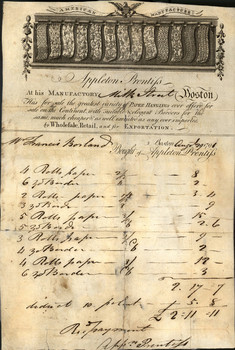 I wish I could make this 1791 billhead bigger to see the graphic in more detail, but I would hyperventilate if a billhead like this came up for sale on ebay - awesome early American with fantastic graphics. Company is Appleton Prentiss wallpaper manufacturer out of Boston.
I wish I could make this 1791 billhead bigger to see the graphic in more detail, but I would hyperventilate if a billhead like this came up for sale on ebay - awesome early American with fantastic graphics. Company is Appleton Prentiss wallpaper manufacturer out of Boston.
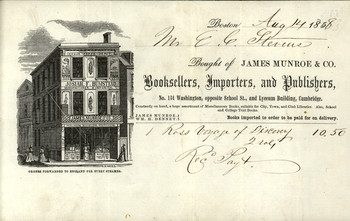 1858 billhead for James Munroe & Co. booksellers, importers and publishers of Boston MA.
1858 billhead for James Munroe & Co. booksellers, importers and publishers of Boston MA.
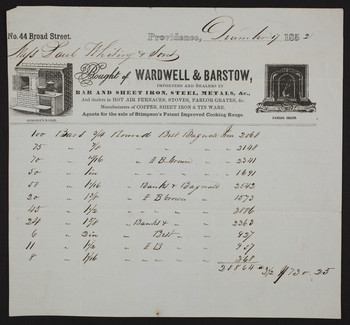 1852 billhead for Wardwell & Barstow importers and dealers in bar and sheet iron, metals, etc. of Providence RI. Nice double graphic.
1852 billhead for Wardwell & Barstow importers and dealers in bar and sheet iron, metals, etc. of Providence RI. Nice double graphic.
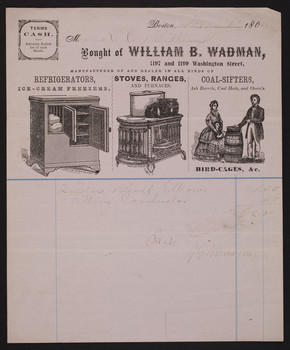 1860 pink colored billhead for William B. Wadman manufacture of all kinds of refrigerators, stoves, ranged, and coal sifters and bird cages of Boston MA. Lovely triple graphic.
1860 pink colored billhead for William B. Wadman manufacture of all kinds of refrigerators, stoves, ranged, and coal sifters and bird cages of Boston MA. Lovely triple graphic.
 1871 red printed billhead for Leonard B. Ellis manufacturer and dealers in looking glasses, picture frames, engravings, and chromo-lithographers of New Bedford MA.
1871 red printed billhead for Leonard B. Ellis manufacturer and dealers in looking glasses, picture frames, engravings, and chromo-lithographers of New Bedford MA.
 1883 letterhead for Williams & Co. soap stone blocks, slabs and manufactured goods with great center factory graphic of Nashua NH.
1883 letterhead for Williams & Co. soap stone blocks, slabs and manufactured goods with great center factory graphic of Nashua NH.
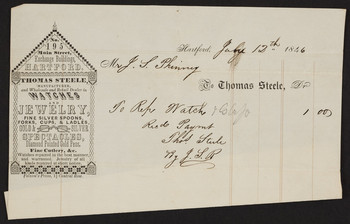 1846 billhead for Thomas Steele - watches, jewelry, spectacles etc. of Hartford CT. Neat graphic in the shape of a building with product list inside.
1846 billhead for Thomas Steele - watches, jewelry, spectacles etc. of Hartford CT. Neat graphic in the shape of a building with product list inside.
 I wish I could make this 1791 billhead bigger to see the graphic in more detail, but I would hyperventilate if a billhead like this came up for sale on ebay - awesome early American with fantastic graphics. Company is Appleton Prentiss wallpaper manufacturer out of Boston.
I wish I could make this 1791 billhead bigger to see the graphic in more detail, but I would hyperventilate if a billhead like this came up for sale on ebay - awesome early American with fantastic graphics. Company is Appleton Prentiss wallpaper manufacturer out of Boston. 1858 billhead for James Munroe & Co. booksellers, importers and publishers of Boston MA.
1858 billhead for James Munroe & Co. booksellers, importers and publishers of Boston MA. 1852 billhead for Wardwell & Barstow importers and dealers in bar and sheet iron, metals, etc. of Providence RI. Nice double graphic.
1852 billhead for Wardwell & Barstow importers and dealers in bar and sheet iron, metals, etc. of Providence RI. Nice double graphic. 1860 pink colored billhead for William B. Wadman manufacture of all kinds of refrigerators, stoves, ranged, and coal sifters and bird cages of Boston MA. Lovely triple graphic.
1860 pink colored billhead for William B. Wadman manufacture of all kinds of refrigerators, stoves, ranged, and coal sifters and bird cages of Boston MA. Lovely triple graphic. 1871 red printed billhead for Leonard B. Ellis manufacturer and dealers in looking glasses, picture frames, engravings, and chromo-lithographers of New Bedford MA.
1871 red printed billhead for Leonard B. Ellis manufacturer and dealers in looking glasses, picture frames, engravings, and chromo-lithographers of New Bedford MA. 1883 letterhead for Williams & Co. soap stone blocks, slabs and manufactured goods with great center factory graphic of Nashua NH.
1883 letterhead for Williams & Co. soap stone blocks, slabs and manufactured goods with great center factory graphic of Nashua NH. 1846 billhead for Thomas Steele - watches, jewelry, spectacles etc. of Hartford CT. Neat graphic in the shape of a building with product list inside.
1846 billhead for Thomas Steele - watches, jewelry, spectacles etc. of Hartford CT. Neat graphic in the shape of a building with product list inside.
Comments